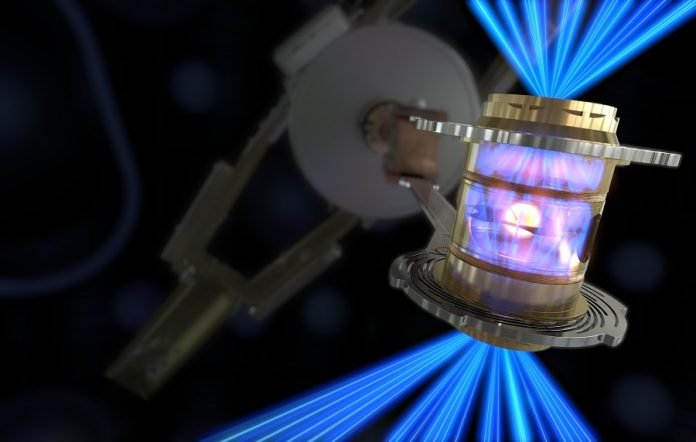
The U.S. Department of Energy on Tuesday announced that a national lab in California made a “major scientific breakthrough”—namely, that it produced a nuclear fusion reaction that resulted in a net energy gain, a condition known as “ignition.”
Federal officials said that the Lawrence Livermore National Laboratory in California, a facility that focuses primarily on simulating nuclear explosions, achieved the long-anticipated breakthrough earlier this month—one that’s being widely reported as a potentially sustainable, low-carbon clean energy solution.
Fusion occurs when two nuclei collide and combine into heavier atoms—here, hydrogen into helium—releasing a burst of energy during the process.
It’s the reaction that powers the sun and other stars; the nuclear fusion process, in nature, is self-sustaining.
During a joint press conference detailing the achievement on Tuesday, National Nuclear Security Administration Administrator Jill Hruby said the fusion experiment involved directing 192 high-energy lasers at a target “about the size of a peppercorn, heating a capsule of deuterium and tritium to over 300 million degrees Celsius (180 million Fahrenheit), and briefly simulating the conditions of a star.”
With that, Hruby said humanity has taken the “first tentative steps toward a clean energy source that could revolutionize the world.” Fusion scientists have been trying to achieve ignition—a break-even point—for decades.
“The idea is that scientists have been trying to get more energy out of a fusion reaction than it takes to put into the fusion reaction in the first place,” says Gregory Fiete, professor of physics at Northeastern.
“This is the first real claim, so far as I know, of crossing the break-even point, where you’ve gotten more energy than you’ve put into this fusion process.”
Fiete notes, however, that the method used to achieve this net energy gain is “not something believed to be scalable to renewable energy.”
When asked about the timeline for commercialization, federal energy officials said on Tuesday that fusion energy solutions still face “very significant hurdles.”
Indeed, the breakthrough, while an extraordinary scientific feat by itself—an important proof of principle—further underscores the long-standing challenges that have prevented sustainable fusion energy from becoming a reality (the joke goes, fusion power is always just decades away).
Fiete says researchers at the lab’s National Ignition Facility (NIF) produce thermonuclear reactions that take place for “fractions of a second,” with the goal of simply observing the physics of these complex phenomena.
It’s one thing, he says, to demonstrate a net energy gain in a controlled setting using costly equipment, and another to create a roadmap for harnessing the resulting energy at scale.
Another lab in construction in Europe, the International Thermonuclear Experimental Reactor, or ITER, plans to investigate fusion energy solutions using a machine called a tokamak, which produces fusion reactions using magnetic fields instead of lasers.
“There the focus is on the clean energy aspect, and it’s a very different technique using magnetic fields to confine the plasma, whereas in NIF, where this breakthrough occurred, they’re using lasers that are focused down to a single point,” Fiete says.
Additionally, the ITER facility will focus on methods for collecting the heat that results from fusion reactions, Fiete says. It’s unclear whether, and if, the methods deployed in the U.S. will translate into methods and strategies for collecting and storing energy that is outlined as part of work to take place at the France-based reactor.
Oleg Batishchev, professor of the practice of physics at Northeastern, says that mankind will need to find a way to mass produce tritium, one of the heavier forms of hydrogen used in nuclear fusion, if the energy sector were to try to pursue solutions based on the NIF experiment.
“What they achieve now is a breakthrough, no doubt,” Batishchev says. “They put some energy in, and they got more energy out. But how do you use it? It’s unclear.”
“You can use electricity to burn hydrogen, for example, but you need the electricity to produce it, so there’s no gain here unless the electricity is free,” Batishchev adds.
“If you use a match to light another match—you’re not gaining much from that. But if you use a match to start a big fire, well then you’re gaining a lot because you have a fire.”
Written by Tanner Stening.



